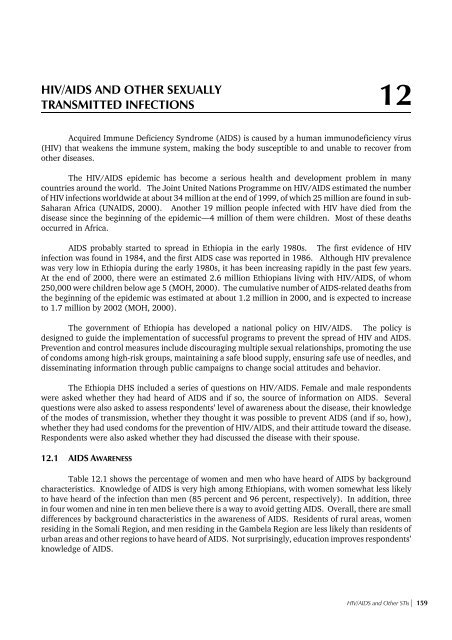PDF, 1536K - Measure DHS
PDF, 1536K - Measure DHS
PDF, 1536K - Measure DHS
Create successful ePaper yourself
Turn your PDF publications into a flip-book with our unique Google optimized e-Paper software.
HIV/AIDS AND OTHER SEXUALLY<br />
TRANSMITTED INFECTIONS<br />
12<br />
Acquired Immune Deficiency Syndrome (AIDS) is caused by a human immunodeficiency virus<br />
(HIV) that weakens the immune system, making the body susceptible to and unable to recover from<br />
other diseases.<br />
The HIV/AIDS epidemic has become a serious health and development problem in many<br />
countries around the world. The Joint United Nations Programme on HIV/AIDS estimated the number<br />
of HIV infections worldwide at about 34 million at the end of 1999, of which 25 million are found in sub-<br />
Saharan Africa (UNAIDS, 2000). Another 19 million people infected with HIV have died from the<br />
disease since the beginning of the epidemic—4 million of them were children. Most of these deaths<br />
occurred in Africa.<br />
AIDS probably started to spread in Ethiopia in the early 1980s. The first evidence of HIV<br />
infection was found in 1984, and the first AIDS case was reported in 1986. Although HIV prevalence<br />
was very low in Ethiopia during the early 1980s, it has been increasing rapidly in the past few years.<br />
At the end of 2000, there were an estimated 2.6 million Ethiopians living with HIV/AIDS, of whom<br />
250,000 were children below age 5 (MOH, 2000). The cumulative number of AIDS-related deaths from<br />
the beginning of the epidemic was estimated at about 1.2 million in 2000, and is expected to increase<br />
to 1.7 million by 2002 (MOH, 2000).<br />
The government of Ethiopia has developed a national policy on HIV/AIDS. The policy is<br />
designed to guide the implementation of successful programs to prevent the spread of HIV and AIDS.<br />
Prevention and control measures include discouraging multiple sexual relationships, promoting the use<br />
of condoms among high-risk groups, maintaining a safe blood supply, ensuring safe use of needles, and<br />
disseminating information through public campaigns to change social attitudes and behavior.<br />
The Ethiopia <strong>DHS</strong> included a series of questions on HIV/AIDS. Female and male respondents<br />
were asked whether they had heard of AIDS and if so, the source of information on AIDS. Several<br />
questions were also asked to assess respondents’ level of awareness about the disease, their knowledge<br />
of the modes of transmission, whether they thought it was possible to prevent AIDS (and if so, how),<br />
whether they had used condoms for the prevention of HIV/AIDS, and their attitude toward the disease.<br />
Respondents were also asked whether they had discussed the disease with their spouse.<br />
12.1 AIDS AWARENESS<br />
Table 12.1 shows the percentage of women and men who have heard of AIDS by background<br />
characteristics. Knowledge of AIDS is very high among Ethiopians, with women somewhat less likely<br />
to have heard of the infection than men (85 percent and 96 percent, respectively). In addition, three<br />
in four women and nine in ten men believe there is a way to avoid getting AIDS. Overall, there are small<br />
differences by background characteristics in the awareness of AIDS. Residents of rural areas, women<br />
residing in the Somali Region, and men residing in the Gambela Region are less likely than residents of<br />
urban areas and other regions to have heard of AIDS. Not surprisingly, education improves respondents’<br />
knowledge of AIDS.<br />
HIV/AIDS and Other STIs* 159








![Obtaining Informed Consent for HIV Testing [QRS4] - Measure DHS](https://img.yumpu.com/49850117/1/190x245/obtaining-informed-consent-for-hiv-testing-qrs4-measure-dhs.jpg?quality=85)








